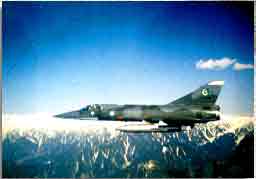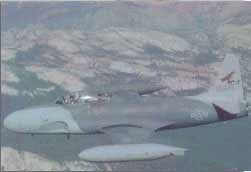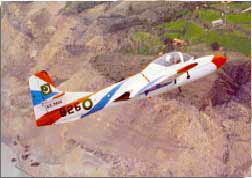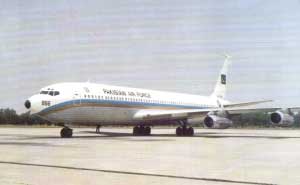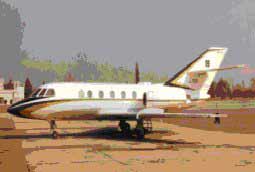PAF AIR BASES Page 2
UMER HOME PAGE
FAVORITE LINKS
PAF AIR BASES
PAF AIR BASES Page 2
PAF FIGHTER PLANES
PAF AIR DEFENCE
PAF ARMAMENT
INTRO OF PAF FIGHTER PLANES
PAF CAREERS
PAF INTRODUCTION
NAMES OF THE PLANES
PHOTO GALLERY
PAF HEROES
UMER GUEST BOOK
PAF BASE LOWER TOPA
Since the early 1930s, the British air force had maintained a small summer training establishment for its officers and men at Lower Topa in the scenic Murree hills. Three years after independence the RPAF decided to continue a similar use of the base by establishing the School of Administration there for airmen trainees. On 1 May 50 Lower Topa became a regular RPAF station whose function was to provide administrative services to the school which was tasked with the training of airmen of non-technical trades. In October 50, the role of the station was enhanced to include the conduct of advanced administrative courses for officers and SNCOs. In August 51, the School of Administration moved to Kohat and, in its place, pre-entry apprentices training was transferred from Kohat. During this period, the station produced 2 cadres of pre-apprentices, one for training at Halton, England, and the other for training at Korangi Creek.
The station was reduced to a care and maintenance status in May 53, when Air Services Training Ltd, UK, with their British staff, took over the training of pre-entry apprentices on the lines of English public schools. When the ongoing pre-apprentice courses were completed by January 54, the only unit that remained at Lower Topa was the PAF Public School.
This institution took shape under the dedicated efforts of its first Principal Mr. F H Shaw and his team, who rendered outstanding service to make the school a top class, pre-cadet institution. In 1959, after the departure of the British staff the school was manned entirely by Pakistani instructors including the Principal, Wing Commander M Daud. Initially the School prepared its students for the matriculation examination of the Punjab University. In 1956, this system was replaced by an internal school leaving examination, but the school reverted to matriculation in 1959. Thenceforth the school flourished and earned an enviable reputation amongst the public schools of the country for its high standards. Presidents Iskander Mirza and Ayub Khan visited the institution in April 56 and July 62 respectively.
In July 67 the school was redesignated as PAF College Lower Topa with the role of educating its students to the mental, physical and moral standards required for entry into the PAF as officers in the GD (P) branch. In July 68, the college was merged with PAF College Sargodha, and in its place, the Initial Training Wing (ITW) of PAF Academy, Risalpur., was established at Lower Topa.
The role of the ITW was to impart initial training to freshly inducted cadets which involved grooming the young men in the initial disciplines of military life. The pilots courses did two terms and the engineering cadets one term at Lower Topa before they joined PAF Academy, Risalpur and the College of Aeronautical Engineering at Korangi Creek. The cadets of the air defence, logistics and accounts branches, after their first term at Lower Topa, were sent to Sakesar and Kohat respectively for their professional training. The training of administrative, education, legal and branch list officers was also conducted at Lower Topa. In December 69 the ITW was redesignated as PAF Station Lower Topa and finally became an air base in October 70. In December 79 the training activities at PAF Lower Topa were terminated and relocated at the PAF Academy.
The base assumed its new operational role in January 85, and has settled down to its new responsibilities with additional facilities that were developed in the mid-80s.
Since the early 1930s, the British air force had maintained a small summer training establishment for its officers and men at Lower Topa in the scenic Murree hills. Three years after independence the RPAF decided to continue a similar use of the base by establishing the School of Administration there for airmen trainees. On 1 May 50 Lower Topa became a regular RPAF station whose function was to provide administrative services to the school which was tasked with the training of airmen of non-technical trades. In October 50, the role of the station was enhanced to include the conduct of advanced administrative courses for officers and SNCOs. In August 51, the School of Administration moved to Kohat and, in its place, pre-entry apprentices training was transferred from Kohat. During this period, the station produced 2 cadres of pre-apprentices, one for training at Halton, England, and the other for training at Korangi Creek.
The station was reduced to a care and maintenance status in May 53, when Air Services Training Ltd, UK, with their British staff, took over the training of pre-entry apprentices on the lines of English public schools. When the ongoing pre-apprentice courses were completed by January 54, the only unit that remained at Lower Topa was the PAF Public School.
This institution took shape under the dedicated efforts of its first Principal Mr. F H Shaw and his team, who rendered outstanding service to make the school a top class, pre-cadet institution. In 1959, after the departure of the British staff the school was manned entirely by Pakistani instructors including the Principal, Wing Commander M Daud. Initially the School prepared its students for the matriculation examination of the Punjab University. In 1956, this system was replaced by an internal school leaving examination, but the school reverted to matriculation in 1959. Thenceforth the school flourished and earned an enviable reputation amongst the public schools of the country for its high standards. Presidents Iskander Mirza and Ayub Khan visited the institution in April 56 and July 62 respectively.
In July 67 the school was redesignated as PAF College Lower Topa with the role of educating its students to the mental, physical and moral standards required for entry into the PAF as officers in the GD (P) branch. In July 68, the college was merged with PAF College Sargodha, and in its place, the Initial Training Wing (ITW) of PAF Academy, Risalpur., was established at Lower Topa.
The role of the ITW was to impart initial training to freshly inducted cadets which involved grooming the young men in the initial disciplines of military life. The pilots courses did two terms and the engineering cadets one term at Lower Topa before they joined PAF Academy, Risalpur and the College of Aeronautical Engineering at Korangi Creek. The cadets of the air defence, logistics and accounts branches, after their first term at Lower Topa, were sent to Sakesar and Kohat respectively for their professional training. The training of administrative, education, legal and branch list officers was also conducted at Lower Topa. In December 69 the ITW was redesignated as PAF Station Lower Topa and finally became an air base in October 70. In December 79 the training activities at PAF Lower Topa were terminated and relocated at the PAF Academy.
The base assumed its new operational role in January 85, and has settled down to its new responsibilities with additional facilities that were developed in the mid-80s.
PAF BASE RAFIQUI
Soon after the 65 war against India a detailed analysis of the PAF's deficient infrastructure led to the decision to build an alternative main base to Sargodha . Early in 1966 two sites were selected, Jhang and Shorkot, a small village 80 miles northeast of Multan. Jhang was the better site in many respects but the land was too expensive and there was pressure on the PAF not to locate an airfield so close to this historic city. The alternative site, Shorkot was then selected and the runway and essential facilities were completed by 1968.
The name PAF Base Rafiqui was bestowed on Shorkot in honour of the gallant warrior of 1965, Squadron Leader S A Rafiqui - an apt name for a fledgling airfield that would see combat so soon after reaching maturity. The airfield had been a satellite for three years. Rafiqui's first base commander Group Captain Zaheer Hussain took over on 3 September 71; one F-86E and half an F-6 squadron were immediately moved there. At the outset of the war that came three months later, an IAF Su-7 was brought down on the runway by the ack. This was the first time Rafiqui had fired its guns in anger. The choice of building Rafiqui at the Shorkot site proved to be an excellent one; this has been borne out by subsequent events and threat developments as well.
After the war, the operational development of the airfield continued at a brisk pace: fuel storage was increased, armament depots were constructed.Hangars and other maintenance facilities were installed to support the projected combat force. In 1973, some additional operational units were added to the base complement. Rafiqui now houses the several major weapon systems in service in the PAF. A large complex of runways, taxiways and tarmacs bristling with aircraft has come into being. With the mushrooming of supporting facilities, the base population expanded from 1 officer and 26 airmen in 1968 to over 3,000 officers, airmen and civilians by 1985, and more than 5,000 people counting their family members. This gave impetus to the growth of civilian amenities in the small town. A cinema and shopping center were added and a cantonment area demarcated.
The desert around the airfield also began to recede. Thousands of trees and several fruit gardens were planted by successive base commanders, the greatest credit for this going to Group Captain Wiqar Azim. The desert of 1968 has by now been turned into a pleasant surrounding of trees and grass with plentiful recreation and sport facilities. A swimming pool, lawn tennis and badminton courts, and a 9-hole golf course have been built. Sixteen years after its inception as a base, Rafiqui in 1988 is no longer a support airfield. It stands shoulder to shoulder with the frontline bases to share the responsibility for national defence in the central sector.
Soon after the 65 war against India a detailed analysis of the PAF's deficient infrastructure led to the decision to build an alternative main base to Sargodha . Early in 1966 two sites were selected, Jhang and Shorkot, a small village 80 miles northeast of Multan. Jhang was the better site in many respects but the land was too expensive and there was pressure on the PAF not to locate an airfield so close to this historic city. The alternative site, Shorkot was then selected and the runway and essential facilities were completed by 1968.
The name PAF Base Rafiqui was bestowed on Shorkot in honour of the gallant warrior of 1965, Squadron Leader S A Rafiqui - an apt name for a fledgling airfield that would see combat so soon after reaching maturity. The airfield had been a satellite for three years. Rafiqui's first base commander Group Captain Zaheer Hussain took over on 3 September 71; one F-86E and half an F-6 squadron were immediately moved there. At the outset of the war that came three months later, an IAF Su-7 was brought down on the runway by the ack. This was the first time Rafiqui had fired its guns in anger. The choice of building Rafiqui at the Shorkot site proved to be an excellent one; this has been borne out by subsequent events and threat developments as well.
After the war, the operational development of the airfield continued at a brisk pace: fuel storage was increased, armament depots were constructed.Hangars and other maintenance facilities were installed to support the projected combat force. In 1973, some additional operational units were added to the base complement. Rafiqui now houses the several major weapon systems in service in the PAF. A large complex of runways, taxiways and tarmacs bristling with aircraft has come into being. With the mushrooming of supporting facilities, the base population expanded from 1 officer and 26 airmen in 1968 to over 3,000 officers, airmen and civilians by 1985, and more than 5,000 people counting their family members. This gave impetus to the growth of civilian amenities in the small town. A cinema and shopping center were added and a cantonment area demarcated.
The desert around the airfield also began to recede. Thousands of trees and several fruit gardens were planted by successive base commanders, the greatest credit for this going to Group Captain Wiqar Azim. The desert of 1968 has by now been turned into a pleasant surrounding of trees and grass with plentiful recreation and sport facilities. A swimming pool, lawn tennis and badminton courts, and a 9-hole golf course have been built. Sixteen years after its inception as a base, Rafiqui in 1988 is no longer a support airfield. It stands shoulder to shoulder with the frontline bases to share the responsibility for national defence in the central sector.
PAFBASE SAMUNGLI
From 14 May to 12 July 1954 RPAF Station Samungli was commanded by Major Sikandar Khan of Pak Army. On 13 July 1954 it was taken over by Squadron Leader K M Akbar. Soon thereafter, a G C Wing was established at the base and Major Sikandar Khan became OC G C Wing.
On I June 57 the annual Shaheen Air Training Corps camp was officially inaugurated at RPAF Samungli. Squadron Leader J Z Mikulski was appointed OC and was assisted by Flying Officer A Hanif, and Sergeants Sabir, Zahoor and Hussain. During June 1957, the SATC wings from Dacca, Sargodha, Drigh Road and Chaklala participated in the camp. They were followed in July by the wings from Lahore and Peshawar.
On 19 October 70, the Care and Maintenance (C&M) Party Samungli was redesignated as PAF Base, Samungli with a proposed location of 2 squadrons by 1974. Between 1970 and 1978 fighter squadrons from Masroor, Sargodha and Peshawar spent several weeks of summer months each year at Samungli.Summer camps for college students were also held annually at the base to make the youth air minded. Until the first fighter squadron became permanently based at Samungli, a fire power and close air support demonstration used to be held every summer for the students of the Quetta Staff College, by squadrons assigned from different air bases of the country. The biggest of these demonstrations was held in September 76 when the participants comprised Nos 5, 7, 11, 15 and 18 Squadrons. The practice continues but most of the air effort is now generated from Samungli itself. PAF Base Samungli remained a satellite base till 31 March 78; thereafter, No 23 Squadron moved there on permanent deployment. In due course, it also became the home base of No 17 Squadron and No 31 Wing was formed in May 83 with the two squadrons. The development of air defence units at the base started in 1981 when HQ No 4 Sector and its component units moved into the area as a consequence of the Afghan war.
Before 1981 the officers' mess of the base was housed in a small hut-type building. Similarly, the SNCO's and airmen's mess were located in old WW II barracks. New messes as well as domestic accommodation and a 20-bed hospital were completed by the end of 1981.
An unusual event occurred on 26 May 81 when an Mi-8 gunship helicopter of the Afghan Air Force was hijacked from Quandhar to Samungli by Captain Jamal-ud-Din of the AAF, with flight engineer Lieutenant Faisal Khan and the pilot's brother Kamal-ud-Din.
After 23 Squadron was assigned its new air superiority role its colour presentation was held at the base on 15 May 82. Lieutenant General Rahim-ud-Din Khan, Governor of Baluchistan, reviewed the parade and presented the colour.
From 14 May to 12 July 1954 RPAF Station Samungli was commanded by Major Sikandar Khan of Pak Army. On 13 July 1954 it was taken over by Squadron Leader K M Akbar. Soon thereafter, a G C Wing was established at the base and Major Sikandar Khan became OC G C Wing.
On I June 57 the annual Shaheen Air Training Corps camp was officially inaugurated at RPAF Samungli. Squadron Leader J Z Mikulski was appointed OC and was assisted by Flying Officer A Hanif, and Sergeants Sabir, Zahoor and Hussain. During June 1957, the SATC wings from Dacca, Sargodha, Drigh Road and Chaklala participated in the camp. They were followed in July by the wings from Lahore and Peshawar.
On 19 October 70, the Care and Maintenance (C&M) Party Samungli was redesignated as PAF Base, Samungli with a proposed location of 2 squadrons by 1974. Between 1970 and 1978 fighter squadrons from Masroor, Sargodha and Peshawar spent several weeks of summer months each year at Samungli.Summer camps for college students were also held annually at the base to make the youth air minded. Until the first fighter squadron became permanently based at Samungli, a fire power and close air support demonstration used to be held every summer for the students of the Quetta Staff College, by squadrons assigned from different air bases of the country. The biggest of these demonstrations was held in September 76 when the participants comprised Nos 5, 7, 11, 15 and 18 Squadrons. The practice continues but most of the air effort is now generated from Samungli itself. PAF Base Samungli remained a satellite base till 31 March 78; thereafter, No 23 Squadron moved there on permanent deployment. In due course, it also became the home base of No 17 Squadron and No 31 Wing was formed in May 83 with the two squadrons. The development of air defence units at the base started in 1981 when HQ No 4 Sector and its component units moved into the area as a consequence of the Afghan war.
Before 1981 the officers' mess of the base was housed in a small hut-type building. Similarly, the SNCO's and airmen's mess were located in old WW II barracks. New messes as well as domestic accommodation and a 20-bed hospital were completed by the end of 1981.
An unusual event occurred on 26 May 81 when an Mi-8 gunship helicopter of the Afghan Air Force was hijacked from Quandhar to Samungli by Captain Jamal-ud-Din of the AAF, with flight engineer Lieutenant Faisal Khan and the pilot's brother Kamal-ud-Din.
After 23 Squadron was assigned its new air superiority role its colour presentation was held at the base on 15 May 82. Lieutenant General Rahim-ud-Din Khan, Governor of Baluchistan, reviewed the parade and presented the colour.

